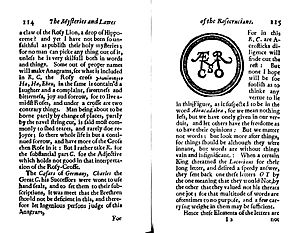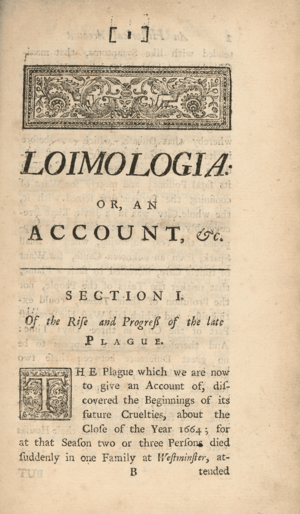Nathaniel Hodges facts for kids
Nathaniel Hodges (born 1629, died 1688) was an English doctor. He is famous for his brave work during the terrible Great Plague of London in 1665. He also wrote an important book about the plague called Loimologia.
Contents
Early Life and Education
Nathaniel Hodges was born in Kensington on September 14, 1629. His father, Dr. Thomas Hodges, was a vicar.
Nathaniel was a bright student. He attended Westminster School as a "king's scholar." Later, he earned a scholarship to Trinity College, Cambridge, in 1646.
In 1648, he moved to Christ Church at University of Oxford. There, he earned his degrees: a Bachelor of Arts (B.A.) in 1651, a Master of Arts (M.A.) in 1654, and finally, a Doctor of Medicine (M.D.) in 1659. While at Oxford, he was part of the Oxford Experimental Philosophy Club. This group explored new ideas in science.
After finishing his studies, Dr. Hodges moved to Walbrook, London. He opened his own medical practice there. In 1659, he became a member of the College of Physicians.
Working During the Great Plague
In 1665, a terrible disease called the bubonic plague spread through London. Many people fled the city, but Dr. Hodges chose to stay. He bravely continued to treat everyone who needed his help.
He started seeing a few possible plague cases in late 1664. By May and June, more people were definitely sick. In August and September, the plague was at its worst. Dr. Hodges worked tirelessly all day long.
Each morning, he would wake up early. He took a special medicine called an "anti-pestilential electuary." This was a thick, paste-like medicine, about the size of a nutmeg. After handling his home tasks, he would go to his consulting room.
Many patients were always waiting for him. For three hours, he would examine them and give them advice. Some were already very sick, while others were just scared. After seeing everyone, he would eat breakfast.
Then, he would visit patients in their homes. Before entering a house, he would burn a disinfectant on hot coals. If he felt hot or out of breath, he would rest. Then, he would put a special lozenge in his mouth before checking on the patient.
After many hours of visiting patients, he would return home. He would drink a glass of sack, which was a type of strong wine. Soon after, he would eat dinner, usually roast meat with pickles. He drank more wine during his meal.
In the evening, he saw more patients at his home. He would then make more house calls, returning home between eight and nine o'clock. He spent his evenings at home, never smoking. He would drink old sack until he felt happy and relaxed. After this, he usually slept well.
Dr. Hodges felt sick twice during the plague, as if he had caught it. But after drinking more sack, he felt better in a few hours. He managed to avoid serious illness. The city leaders were very grateful for his courage. They gave him a special payment for his services during the plague.
Later Life and Writings
The College of Physicians recognized Dr. Hodges' important work. They made him a fellow in 1672. In 1682, he was a "censor," which meant he helped oversee the college. He even gave the college a fire-engine.
Dr. Hodges also wrote several books. In 1654, he contributed to a book of poems celebrating peace with the Dutch. In 1666, he wrote a book called ‘Vindiciæ Medicinæ et Medicorum.’ This book was an apology for doctors and the medical profession. It also criticized quacks, who were people pretending to be doctors. He also helped translate Aurea Themis by Michael Maier in 1656.
His most famous work is Loimologia, sive Pestis nuperæ apud Populum Londinensem grassantis Narratio Historica. He finished this book in 1671, and it was published in 1672. It was a detailed account of the plague in London. Dr. Hodges carefully observed the symptoms of the disease and how different treatments worked.
He tried some unusual remedies like Bezoar (a stone-like mass found in animal stomachs), unicorn's horn, and dried toads. He found these were not helpful. However, he realized that serpentary (a plant) could help people sweat, which was good. He also found that hartshorn (from deer antlers) could help stimulate the heart. He even described a heart condition called pericarditis in a plague patient. A translation of Loimologia was published in 1720.
Sadly, Dr. Hodges' medical practice did not continue to grow. He faced financial difficulties and died on June 10, 1688, while struggling with debt. He was buried in St Stephen's, Walbrook, where a bust and inscription honored him.
Images for kids





